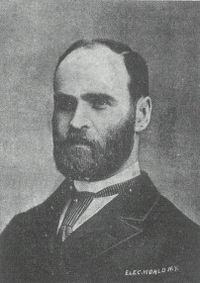Alexander Macfarlane Scientist
Alexander Macfarlane FRSE (21 April 1851 – 28 August 1913) was a Scottish logician, physicist, and mathematician.Macfarlane was born in Blairgowrie, Scotland and studied at the University of Edinburgh. His doctoral thesis "The disruptive discharge of electricity" reported on experimental results from the laboratory of Peter Guthrie Tait.In 1878 Macfarlane was elected a Fellow of the Royal Society of EdinburghDuring his life, Macfarlane played a prominent role in research and education. He taught at the universities of Edinburgh and St Andrews, was physics professor at the University of Texas (1885 – 1894), professor of Advanced Electricity, and later of mathematical physics, at Lehigh University. MacFarlane was the secretary of the Quaternion Society and compiler of its publications.Macfarlane was also the author of a popular 1916 collection of mathematical biographies (Ten British Mathematicians), a similar work on physicists (Lectures on Ten British Physicists of the Nineteenth Century, 1919), and he compiled a bibliography on quaternions in 1904.Macfarlane was caught up in the revolution in geometry during his lifetime, in particular through the influence of G. B. Halsted who was mathematics professor at the University of Texas. Macfarlane originated an Algebra of Physics, which was his adaptation of quaternions to physical science. His first publication on Space Analysis preceded the presentation of Minkowski Space by seventeen years.Macfarlane actively participated in several International Congresses of Mathematicians including the primordial meeting in Chicago, 1893, and the Paris meeting of 1900 where he spoke on "Application of space analysis to curvilinear coordinates".Macfarlane retired to Chatham, Ontario, where he died in 1913.
Search
Scientist
| doctoral advisor | |
|---|---|
| Field of study | |
| influenced | |
| influenced by |
Alexander Macfarlane on Wikipedia
External resources
- http://babel.hathitrust.org/cgi/pt?id=pst.000052363498;view=1up;seq=337
- http://babel.hathitrust.org/cgi/pt?id=pst.000052363498;view=1up;seq=426
- http://babel.hathitrust.org/cgi/pt?id=pst.000052363498;view=1up;seq=480
- http://babel.hathitrust.org/cgi/pt?id=pst.000052363498;view=1up;seq=481
- http://ebooks.library.cornell.edu/cgi/t/text/text-idx?c=math;cc=math;view=toc;subview=short;idno=05070001
- http://www.archive.org/details/lecturesontenbri00macfrich
- http://www.electricscotland.com/history/canada/kent/macfarlane_alexander.htm
- http://www.lib.utexas.edu/taro/utcah/00515/cah-00515.html
- http://www.nature.com/nature/journal/v92/n2291/pdf/092103a0.pdf
- http://www.webcitation.org/5kmWeo7j0
